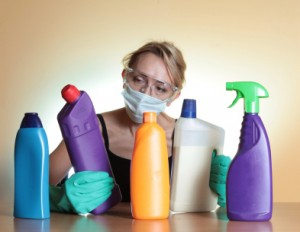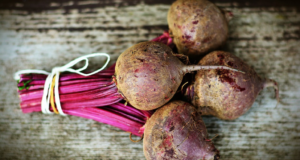We’ve all seen those commercials for various cleaning products that claim to kill up to 99 percent of household germs. If you are a new parent then this can be very appealing, especially if you’ve been alarmed by the number of reported cases of food poisoning in recent years. Contaminated spinach and cantaloupe reports are not just an excellent reason for us to all be making the effort to grow as much of our own food as possible, but they are also hardly a good reason to completely sterilize your home with chemical cleaners.
There are several truths about these antibacterial disinfectants that we should all be acutely aware of so that we can make the best and healthiest choices for our families.
Antiseptics Vs. Disinfectants
 There are two words that are often used exclusively of one another: antiseptics and disinfectants. While the application of each may differ, they have one thing in common and that is that they destroy any bacteria that they come into contact with. The distinction between these two bacteria-killing substances lies in the application, because antiseptics are typically used to destroy bacteria that are present on our skin or on the skin of our animals. Disinfectants, on the other hand, are used to destroy bacteria present on solid surfaces, like floors, tables, sinks, and so on.
There are two words that are often used exclusively of one another: antiseptics and disinfectants. While the application of each may differ, they have one thing in common and that is that they destroy any bacteria that they come into contact with. The distinction between these two bacteria-killing substances lies in the application, because antiseptics are typically used to destroy bacteria that are present on our skin or on the skin of our animals. Disinfectants, on the other hand, are used to destroy bacteria present on solid surfaces, like floors, tables, sinks, and so on.
Antiseptics are most often used to help protect a scrape or other wound from exposure to bacteria in the air, which can also help to speed up the healing process while prevent a massive infection from settling in.
Antiseptics are also used to help sterilize the skin before intentional cuts, as in the case of surgeries. These types of bacteria killing and prevention compounds have a vital role to play in the medical field, as do the types of antibacterial disinfectants that help to sterilize medical equipment and hospital surfaces.
But do they really belong in our homes? While certainly we want to do our best to eliminate salmonella and E. coli from our homes, there are millions of other kinds of bacteria that actually have a valuable role to play in our homes.
How Do They Really Work?
How much thought do you give to it when you pull that disinfecting wipe out and do a quick once-over on your kitchen counters? What about when you pour a bit of it into a bucket to mop your floors? The majority of us give very little thought to these chemicals at all!
Just how do they work?
There are several compounds that are used for their disinfecting properties. Some of them include the following:
- Potassium permanganate
- Iodine
- Hydrogen peroxide
- Aldehydes
- Chlorine bleach
- Alcohols
Each of these types of disinfectants will work in a different, yet equally as effective, way. Consider chlorine bleach, for example. The way it works is by swiftly oxidizing the complex molecules that are evident on the bacteria’s surface. This causes the walls of the bacteria cells to split apart at an incredibly rapid rate, which prevents the cell from being able to repair itself. Bacteria are then killed within seconds of being exposed to the chlorine bleach compounds.
Disinfectants are not necessarily able to kill every form of bacteria, especially since some may be resistant to even chlorine bleach. While there are some that are resistant to the disinfectant properties of many cleaning solutions, disinfectants, antiseptics, and antibiotics are not selective about the bacteria that they destroy.
Another side effect to using chemical disinfectants is that they often contain ingredients that are toxic, known carcinogens, and leave harmful residue on the surfaces in our homes—not to mention the fumes so often associated with chemical cleaning products. If you’ve ever cleaned your kitchen floor with bleach or an artificially scented pine cleaning product, then you are more than familiar with the fumes that can accompany them.
Are There Any Good Bacteria?
We all know that eating contaminated food or preparing meals on contaminated surfaces can make us very ill, and even potentially be lethal. Clostridium, E. coli, and Salmonella, for example, are very serious concerns that we should all be mindful of.
However, there are also dozens of so-called friendly bacteria that are actually beneficial and shouldn’t be eliminated from our environments. Our digestive tract is also home to billions of bacteria that all perform a vital role in healthy digestion and good overall health. When we start to eliminate all bacteria from our homes and our food, we start down two potentially troublesome pathways:
- We could be forcing certain strains of bacteria to become more resistant to the disinfectants and antibiotics that we take.
- We could be sending our bodies and our immune systems into an unhealthy tailspin of sterility that leaves us vulnerable to attack from illness and harmful bacteria.
There is evidence to support the fact that healthy levels of bacteria in our digestive tract can help us to maintain a much healthier digestive system. They can help to keep things moving, so to speak, help to reduce blood pressure, help to reduce stomach ulcers, and may even have an effect on the development of polyps that could lead to cancers.
Studies have also started to consider the benefits of exposure to relatively harmless bacteria as pertains to building a strong and healthy immune system. If a person has been exposed to good numbers of relatively healthy and harmless bacteria, then the common cold or other infections might not be as severe as they would be on a body that has a very limited immunity built up.
There are also numerous concerns about chemical cleaners that work to destroy bacteria also being responsible for an increase in cases of asthma and other respiratory illnesses, especially amongst children.
Where Might We Consider Using Them?
Washing our hands with antiseptic soaps can help to remove bacteria that may be present because we’ve been working with animals, manure, or otherwise getting dirty. But keep in mind that these soaps often strip all of the moisture and bacteria from our hands, even the good bacteria that could help to keep the bad guys from entering into small cuts and scrapes on our hands.
A good quality moisturizing lotion, one that contains beeswax or coconut oil for example, can help to restore moisture to our hands once we’ve scrubbed them clean.
Other places where you may find it beneficial to use antibacterial disinfectants include the following.
- Trash bins
- Toilets
- Drains
Using them in your kitchen might be helpful if you have a spill of meat or perhaps spread soil-covered vegetables all over your workspace. However, there are very few types of bacteria that won’t respond to good old hot water or steam instead of chemical cleaning products that may leave a toxic residue behind them.
Antiseptics and disinfectants should be used in hospitals and other types of medical facilities in order to help keep the spread of bacteria down to a minimum, but in our home, these types of products don’t have as much of an application. Think about your baby’s environment when you bring a new baby into your home. Certainly you want to sterilize her bottles and pacifiers in order to prevent an oral infection, but are the bacteria surrounding us all at any given moment truly more of a threat to her than if you were to spray chemical disinfecting sprays, or clean the floor she sits on with chlorine bleach?
Keeping It Clean
Marketing companies have been very effective at convincing us that our homes are filthy spaces that are making us all violently ill. While some people could definitely use a crash course in basic hygiene, you’ll likely find that your home is a perfectly normal and natural environment for you and your family.
Simply follow a few basic household cleaning steps, use natural cleaning products, and you are all sure to be completely healthy and content, with strong immune systems.
Some cleaning staples to have around your home should include baking soda, white vinegar, essential oils, washing soda, and lemon juice. A simple paste made using salt and vinegar will get your sink spotless, fresh, and disinfected. Vinegar can also be diluted in hot water to work as a very effective household floor cleaner, or bathroom surface cleaner. A few drops of rosemary, lavender, or thyme essential oil can boost the disinfectant properties of vinegar. Lemon juice can add a nice fresh scent to your floors, and when combined with a bit of coconut or olive oil, it can help to keep your wooden floors and wooden furniture clean and shining.
Natural cleaning solutions will help to keep your home clean, smelling great, free from toxins, and won’t have a massive impact on the harmless bacteria that should be naturally occurring in our homes.
©2012 Off the Grid News
 Off The Grid News Better Ideas For Off The Grid Living
Off The Grid News Better Ideas For Off The Grid Living



